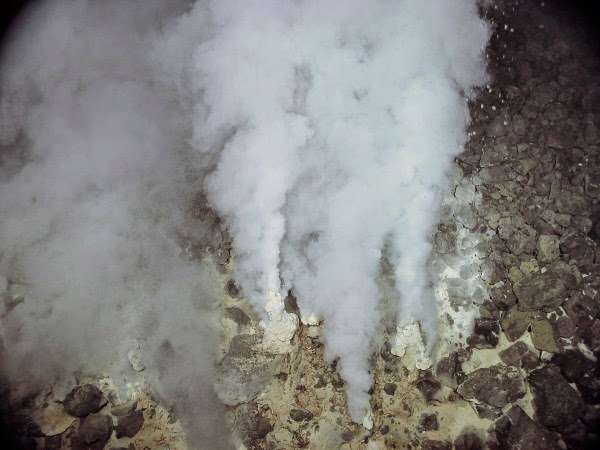
On ancient Earth, the earliest life encountered a paradox. Chains of RNA—the ancestor of DNA—were floating around, haphazardly duplicating themselves. Scientists know that eventually, these RNA chains must have become longer and longer, setting the stage for the evolution of complex life forms like amoebas, worms, and eventually humans. But under all current models, shorter RNA molecules, having less material to copy, would have reproduced faster, favoring the evolution of primitive organisms over complex ones. Now, new research offers a potential solution: Longer RNA chains could have hidden out in porous rocks near volcanic sites such as hydrothermal ocean vents, where unique temperature conditions might have helped complex organisms evolve.
Hydrothermal vents are fissures in Earth’s crust that pump out superheated water. They would have been common on early Earth, which was more tectonically active than the planet is today, says Dieter Braun, an experimental biophysicist at Ludwig Maximilian University in Munich, Germany. The water in hydrothermal vents is particularly rich in nutrients, making them promising sites for the origin of life.
To figure out if hydrothermal vents could have given the evolution of complex life a boost, Braun and his colleagues examined the physics of a theoretical single pore in the rock surrounding a vent. The pore is open at the top and at the bottom and filled with a dilute solution of RNA molecules of various lengths. The solution on the hot side—the one closer to the stream of superheated water—would become less dense and rise up through the pore. Some of it would escape at the top, to be replenished by more nutrient-rich fluid entering at the bottom. The remainder would diffuse across to the cold side of the pore and drop back down. A complex physical effect called thermophoresis causes charged molecules in a solution to accumulate in colder water, and the longer chains, having more charge, would do this more often than shorter chains. Therefore, the shorter RNA chains would be more likely to escape out of the top of the pore, whereas the longer ones would stay trapped inside where, continually fed by nutrients, they could reproduce. Better still, Braun says, the continuous temperature cycling could actually help split the RNA double helix apart, making it easier for it to reproduce.
To test this elaborate hypothesis, Braun and his colleagues constructed a simulated piece of porous rock from a network of tiny glass capillary tubes heated on one side. They allowed dissolved fragments of DNA to be washed into the tubes from the bottom. Ideally, they would have used RNA, but Braun explains that there’s no good way to reproduce RNA in a lab, whereas it’s easy to reproduce DNA with a standard laboratory process called PCR. “All the thermophoresis and the characteristics of the trapping mechanism are the same for DNA and RNA,” he says. Once they let the experiment run, the researchers found that longer chains of DNA were more likely to accumulate inside the tubes than shorter chains were. As a result, the longer strands reproduced much better inside the pores and their populations grew, whereas the shorter strands were diluted so much that they went extinct, the team reports online today in Nature Chemistry.
It’s “nice chemistry,” says marine chemist Jeffrey Bada of the University of California (UC), San Diego, but he is not convinced that hydrothermal vents, or any other likely habitat on early Earth, could have provided the conditions created in the lab: “The processes outlined are not likely to take place on a significant scale on the Earth or elsewhere.” Biochemist Irene Chen of UC Santa Barbara disagrees and even thinks the research opens a door to studying environments beyond just volcanic ones. She suggests rock pores hotter on one side than the other could result from solar, as well as hydrothermal, heating, expanding the types of environments that could have favored the evolution of complex life. A physical environment that could plausibly have existed on the early Earth “actually selects for longer RNA sequences,” she says. “The extra length is basically room for biological creativity.”
Note : The above story is based on materials provided by American Association for the Advancement of Science. The original article was written by Tim Wogan.










